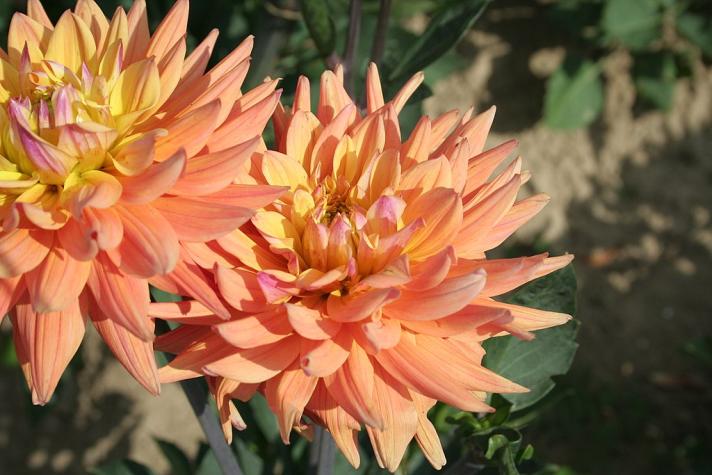Writer
Linda GeistCOLUMBIA, Mo. – As autumn approaches, many garden flowers show the ravages of a long, often brutal summer. However, it’s at this time that dahlias are most spectacular, said University of Missouri Extension horticulturist David Trinklein. Warm days and cool nights associated with late summer and early fall cause dahlias to produce flowers with intense, dazzling color.
Enjoy this popular flower’s explosion of color in September, said Trinklein. Start planning for dahlias next spring if you do not already grow them.
A member of the aster plant family, dahlia is the national flower of Mexico. Aztecs were growing dahlias when Spanish conquistadors arrived in the 16th century. The Spaniards brought botanists with them to select plants to take back to Spain. Dahlia was one of the plants selected.
Early dahlias imported into Europe were of the single-flower type. As hybridization began, the first fully double-flowered forms and new color combinations appeared. Several hundred years later, dahlia has one of the largest arrays of flower forms, colors and sizes of any cultivated plant. To date, there are more than 50,000 named and arranged cultivars.
When most people think of dahlia, the tall types propagated from tuberous roots each year come to mind. “Indeed, the majority of named dahlia cultivars are of this type,” Trinklein said. “They are popular for the cutting garden or the backdrop of borders.” However, because of their tall stature and large flowers, this type requires staking or some additional support.
Dwarf or bedding dahlias propagated from seed have gained popularity in recent years. Bedding dahlias produce large amounts of small flowers on bushy plants. This makes them ideal for annual beds or fronts of borders. Although these dahlias also form tuberous storage roots, most gardeners do not save them from year to year because of the availability of inexpensive plants each spring, Trinklein said.
Plant dahlias in an airy location where they receive at least six to eight hours of direct sun and protection from high winds. Plant tuberous roots of large types of dahlias about 14 days before the frost-free date for an area. Since dahlias cannot endure freezing temperatures, do not set out plants started indoors until the danger of frost has passed.
Dahlias grow well in fertile, well-drained garden soils high in organic matter. If soil lacks organic matter, add up to 4 inches of well-rotted manure, compost or other forms of organic matter before planting.
Prepare soil by incorporating about one-half cup of a garden fertilizer high in phosphorus and potassium but low in nitrogen, such as 5-10-10, in a 2-foot circle where each plant is to be located. Top dress with an equal amount of fertilizer in July. Dahlias grow rapidly and need lots of water. Keep soil moist but not wet.
Dahlias also benefit from pruning. The amount of pruning depends upon the flower’s intended use. Prune exhibition-type flowers to one main stem. Pinch plants for lavish garden display after first growth in the spring reaches a height of about 1 foot. A second pinch after emerging shoots reach a length of 1 foot delays flowering but makes for a more spectacular display late in the growing season.
Botrytis (gray mold) blight and powdery mildew are two foliage diseases that affect dahlia. Avoid these diseases by strict sanitation, proper site selection and keeping foliage as dry as possible. Fungicides containing thiophanate methyl also provide effective disease prevention, said Trinklein.
Since most gardeners save dahlia’s tuberous roots from year to year, some viral diseases such as dahlia mosaic virus occur. Sanitation, insect control and selection of tolerant cultivars control these.
Dahlias do not tolerate frost in Missouri’s latitude. Dig roots and store each fall after the tops have died back. After digging, wash off remaining soil and let the roots dry. Do not dry them in direct sunlight. Separate tuberous roots in the fall by cutting them from the main stem. Allow the portion of the stem attached to the part containing the eyes to remain. Dust cut ends with a fungicide to discourage storage diseases.
You can also leave the entire root system intact and separate the next growing season. Pack the roots in moist peat moss, sawdust or other inert organic material and place in a wooden or cardboard box. Ideal temperature for storing roots is 40 to 45 F.
Find more information about dahlias and their care on the American Dahlia Society website at www.dahlia.org.
Photo
https://commons.wikimedia.org/wiki/File:Dahlia_karma_Corona.JPG
Dahlia ‘Karma Corona.’ Photo by Loïc Evanno via Wikimedia Commons. Shared under a Creative Commons license (CC-BY-SA 2.5).
